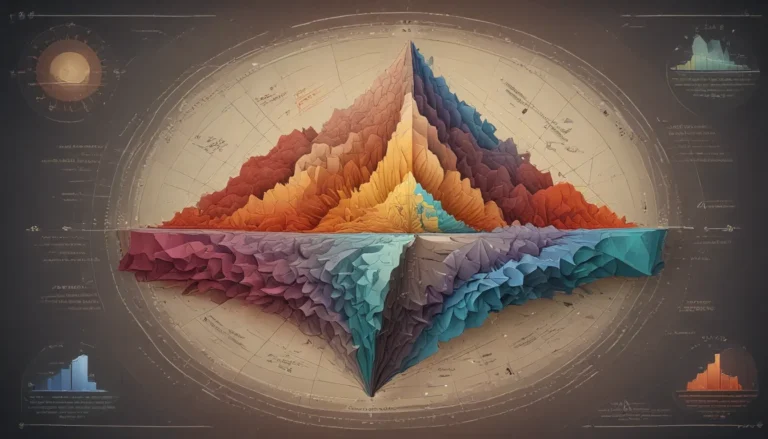A Note About Images: The images used in our articles are for illustration purposes only and may not exactly match the content. They are meant to engage readers, but the text should be relied upon for accurate information.
Crystallography is a captivating branch of science that delves into the intricate structures and properties of crystals. Through the study of atomic and molecular arrangements within crystal lattices, crystallographers gain valuable insights into the physical and chemical characteristics of these beautiful substances. Join us on a journey to explore the wonders of crystallography and discover 18 fascinating facts that showcase the significance and impact of this field.
Unveiling the World of Crystallography
Crystallography is a scientific discipline that focuses on the atomic and molecular structures of crystals. By exploring how atoms and molecules are arranged within crystals, scientists can better understand the unique properties that define these remarkable substances.
The Symmetry of Crystals
Crystals possess a repeating, symmetric pattern of atoms or molecules that gives them their characteristic shape and structure. This regular arrangement allows scientists to study and analyze crystals using various crystallography techniques.
Vital Role in Science
Crystallography plays a crucial role in a wide range of scientific fields, including chemistry, physics, material science, geology, and biology. By unraveling the fundamental properties of materials, crystallography contributes to advancements in diverse industries.
The Power of X-ray Crystallography
X-ray crystallography is a widely used technique in crystallography that involves directing X-rays at a crystal to determine its atomic and molecular structure. This technique has led to breakthroughs in genetics, drug discovery, and nanotechnology.
Applications in Drug Discovery
Crystallography is instrumental in drug discovery, as it helps scientists understand how drug molecules interact with target proteins at an atomic level. This knowledge is used to design more effective and targeted drugs for various medical conditions.
Designing New Materials
By studying the crystal structures of different materials, scientists can develop new materials with specific characteristics for fields such as electronics, aerospace, and energy storage. Crystallography plays a vital role in advancing materials science.
Unlocking the DNA Structure
Using X-ray crystallography, James Watson and Francis Crick discovered the double helix structure of DNA in 1953. This groundbreaking revelation laid the foundation for our understanding of genetics and molecular biology.
Revealing the Secrets of Gemstones
Crystallography techniques enable researchers to examine the atomic structure of gemstones, providing insights into their unique optical and physical properties. This knowledge assists in distinguishing genuine gemstones from imitations.
Understanding Protein Structures
Protein crystallography focuses on determining the three-dimensional structures of proteins, which is essential for understanding their functions and developing targeted therapies. This field plays a crucial role in the study of biological systems.
Exploring Crystal Symmetry
Crystal structures often exhibit various symmetrical arrangements, such as cubic, tetrahedral, or hexagonal symmetry. By analyzing crystal lattice symmetry, scientists can gain valuable insights into the properties and behavior of crystals.
Visualizing Atomic Arrangements
Crystallography techniques like electron microscopy and neutron diffraction allow scientists to visualize the arrangement of atoms in crystals. This provides crucial information about bonding, crystal defects, and other structural features.
Studying Crystal Growth
Through crystallography, scientists can study the growth mechanisms of crystals and control their formation to optimize their properties. This knowledge is indispensable for applications in materials science and engineering.
Aiding in Mineralogy
Crystallography plays a significant role in mineralogy by helping scientists identify and classify minerals based on their crystal structures. This understanding contributes to our knowledge of Earth’s geological processes.
Designing Catalysts
Crystallography aids in the development of more efficient catalysts by studying the atomic arrangement and surface properties of catalyst materials. This has important implications for chemical reactions in various industrial processes.
Investigating Crystal Defects
Crystallography allows scientists to investigate and understand crystal defects, which can significantly impact material properties. By studying these defects, researchers can improve materials’ performance and durability.
Driving Nanotechnology Advancements
Crystallography is vital for the advancement of nanotechnology by providing insights into the atomic and molecular arrangements of nanostructures. This knowledge is essential for designing nanoscale devices with unique properties.
Forensic Applications
Forensic crystallography is used in analyzing materials found at crime scenes, such as glass fragments or illicit drugs. By examining their crystal structures, scientists can provide valuable evidence in criminal investigations.
Pushing the Boundaries of Science
The field of crystallography continues to push the boundaries of scientific understanding, uncovering new insights into the atomic and molecular world. Its applications span various disciplines and contribute to ongoing scientific progress.
Conclusion: Embracing the Marvels of Crystallography
In conclusion, crystallography is a captivating field that sheds light on the atomic and molecular structures of diverse substances. From unraveling the mysteries of crystals to aiding in drug development, crystallography has far-reaching applications that drive scientific advancements.
Through techniques like X-ray crystallography, researchers gain valuable insights into the properties of crystals, leading to innovations in materials science, pharmaceuticals, and biological research. As crystallographic methods evolve, new discoveries and innovations await those who delve into the captivating world of crystallography.
FAQs: Exploring Crystallography
Q: What is crystallography?
A: Crystallography is the scientific study of crystals and their atomic and molecular structures, involving techniques like X-ray diffraction to determine atomic arrangements.
Q: What are some practical applications of crystallography?
A: Crystallography is used in materials science, drug development, biology, and other fields to study crystal structures and properties.
Q: How does X-ray crystallography work?
A: X-ray crystallography involves directing X-rays at a crystal, measuring the diffraction pattern, and determining the atomic arrangement within the crystal.
Q: Is crystallography only relevant to chemistry?
A: Crystallography has applications in various scientific disciplines beyond chemistry, including materials science, biology, geology, and physics.
Crystallography offers a world of discovery and innovation, unveiling the hidden structures and properties of crystals. Whether you are a scientist, student, or curious explorer, the captivating realm of crystallography is sure to inspire wonder and ignite a passion for scientific exploration. Dive into this enchanting field and unlock a treasure trove of knowledge that continues to shape our understanding of the natural world.






